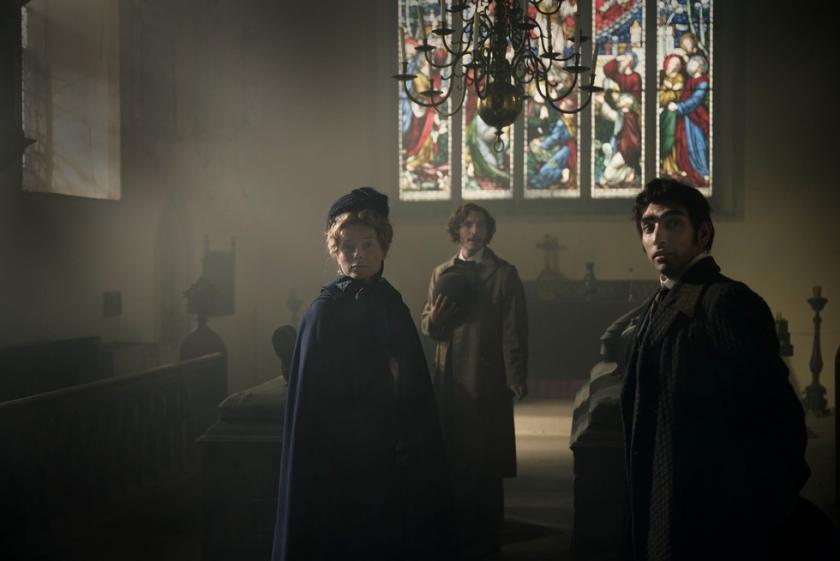There are no white-sheeted ghosts in this year’s A Ghost Story for Christmas. The BBC’s annual adaptations of MR James’s best-known stories have been a holiday favourite since the 1970s.
More recently, in the hands of writer-director Mark Gatiss (pictured below), the series has been mining dread from the work of authors less well known for horror: Arthur Conan Doyle, for last year’s Lot 249, and Edith Nesbit (author of The Railway Children and Five Children and It) for this year’s tale, which is based on Man-Size in Marble. In the new adaptation, titled Woman of Stone, a malevolent force awakens in a small English village, threatening all who dare to disturb it.
Gatiss, who got his start with the comedy trio The League of Gentlemen, is a lifelong horror and suspense reader who grew up to co-create, with Stephen Moffat, television reboots of Doctor Who and Sherlock Homes.
Typical of Gatiss, he revives Man-Size in Marble in an unexpected manner. In the original story, a bewildered husband gets the first – and last – word. In Woman of Stone Nesbit herself (Celia Imrie) tells the story to entertain her handsome young doctor (Marwaan Rizwan). In the tale-within-a-tale, local housekeeper Mrs. Dorman (Monica Dolan) warns newlyweds Laura and Jack to stay away from a nearby, disused church lest they encounter its terrible secret.
 JUSTINE ELIAS: Woman of Stone is a huge reversal from the pre-war antiquarians and archaeologists of MR James. What set you in a new direction?
JUSTINE ELIAS: Woman of Stone is a huge reversal from the pre-war antiquarians and archaeologists of MR James. What set you in a new direction?
MARK GATISS: I wanted contrast. Last year, the timing worked well with Lucy Worsley’s documentary series about Conan Doyle. Man-Size in Marble is the first ghost story I ever read. It scared me to death. But it's short, it's slight. So I read around it: I read Eleanor Fitzsimons fantastic biography of Edith Nesbit. I was intrigued to the extent to which she tolerated her husband’s infidelity and misdeeds. She was a contradictory person: she wasn’t a really a feminist. She didn’t believe women should have the vote. Yet she kept her household running almost singlehandedly with her writing. I thought maybe there’s something in this I can refashion, to retell this story as she is dying, thinking, “Maybe I should have been a bit less forgiving.” That's why E. Nesbit is telling the story.
The young couple, Laura (Phoebe Horn) and Jack (Éanna Hardwick) adore each other, but he belittles her, calling her “wifey”, “pussy”, “dearie". Where’s that coming from?
Mrs Dornan knows, doesn't she? When Mrs Dornan tells the story of the Crusader knight effigies, she says, with great bitterness, “When they got back from their wars, whatever their wars was.” I meant that very strongly. It's men! Men, stupid toxic men, that’s why we’re in all these messes. When you read Nesbit, you cannot help but feel how Jack patronises Laura, berates her, how he doesn’t listen. And even if they weren’t really aware of it in Victorian times, or Nesbit’s, the story pointed to it. That, to me, is what the story is about: domestic violence. A period film shouldn’t just be an exercise in nostalgia. There’s a way of doing a period piece and keep moving forward.
Why does Nesbit’s writing endure?
She wrote for children without any sense of condescension. Brilliantly. She had a formative experience when she was about eight years old: her father had died, her sister was ill, and her mother used to drag them across Europe in search of clean air. They were in Bordeaux and someone asked if they wanted to see the mummies. She thought, “It’ll be like home, like the British Museum.” So she was were led into a catacomb and – voila! – she’s in a catacomb full of 200 desiccated corpses hanging from wires, and it absolutely scared her to death. In her stories, there are loads of inanimate things that come to life.
MR James, who told his stories aloud, spoke of evoking a “pleasing terror” in listeners. How can one do that in a film, where you can see and show everything?
Sound is crucial in horror. I had a long debate with myself about how much to show. In the story, the only evidence [of the supernatural] is the broken-off marble finger. Then on location, I knew if we don’t shoot something – something more – I would regret it. I remembered something that terrified when I was, I don’t know tiny: Jason and the Argonauts, when the statue of Talos comes to life. There’s stillness, silence, and then this awful grinding sound as the statue moves. It’s thrilling
When and how did Christmas in Britain and Ireland become associated with ghosts?
A Christmas Carol and Charles Dickens – the fact that the story was a worldwide smash and fused ghosts and Christmas in the public imagination. There’s something about the fusion of those two things, and the older tradition of telling stories on the long nights. This season is a liminal time, where we look backwards and forwards and think about people we’ve lost. We feel uncertainty about the future. There is something rather lovely about the shadow of a Christmas tree, when everything else is so sparkly and bright and optimistic. Think of It’s A Wonderful Life, which has an undeserved reputation as a piece of schmaltz. It's one of the darkest, most despairing films ever made, except for the last five minutes.
Horror movies often don’t sustain dread, or even shock, after the ghost makes itself known. Where do you go from there?
You have to think of short stories, short films, and films differently. The Turn of the Screw – as well as being the only thing by Henry James that I think is readable – is a longer form story with multiple hauntings, multiple scares. And it’s good to consider different authors. So many authors of Dickens era had a go at a ghost story, and it’s fun to see how each one went for the same effect. What I tend to do, there’s more than a little influence of EC Comics. [Adaptations] need a twist, because many stories, particularly those by MR James, sort of fade away at the end. So there has to be more. Without spoiling it, I said to Monica Dolan, “You know, Mrs Dornan does this every year. She waits for the house to fall empty, lures a couple there and...”
What are you working on now?
I am writing something about seances, because I’m obsessed with them. I’ve been to a séance, an entertainment, staged like a Victorian séance, and you see how all the tricks are done. I find it incredible that people still fall for a parlour trick. You can tell them how it’s done and they don’t want to hear it. It’s so obvious! Afterwards people will insist, “No! The medium’s got powers, he just doesn’t realise it.” It’s just cold reading. A better question is, “Why are the questions so banal? Why don’t you ask them what it’s like to be dead?”
Do you believe in ghosts? And if you don’t, what are people seeing?
Ghosts fascinate me. Not the idea of continuing on after death – more the physics of it. I heard a quantum physicist talk about the multiverse. He believes it’s possible that sometimes, for no reason, time jumps the track. You see, briefly, someone who used to live there. Or who will live there. Civilisation has a strong need to believe in religion. Or superstition. Whatever hauntings are, there must be something to it. It’s reported for thousands of years in every culture. But no, I don’t believe in dragging chains and literal ghosts.
What aspect of your career in horror made you cringe?
Jeremy Dyson directed me in a short film called The Cicerones, based on a Robert Aickman story. We went on breakfast TV for it. Aickman is the subtlest writer, the ghost story writer’s ghost story writer. As we were explaining what the film was, we could see the presenter, off camera, putting on a werewolf mask. The camera would cut from us to him in the mask and... I couldn’t bear it. I wanted to die.
- A Ghost Story for Christmas: Woman of Stone airs at 10.15pm on BBC2
- More TV reviews on theartsdesk















Add comment